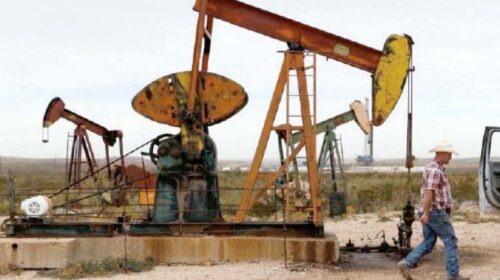US investment bank Goldman Sachs expects Brent crude to trade at $105 a barrel by the fourth quarter of 2023, driven by a “solid” growth in global oil demand.
It expects oil demand to grow by 2.7 million barrels per day this year and said the market would be back in a deficit in the second half of 2023.
This should allow the Opec+ alliance to unwind its October production cut in the second half of the year, said Goldman Sachs.
However, if the market turns out to be softer, then alliance “could stick to its October cuts or cut production even further, given its significant pricing power”.
“Overall, this ‘Opec put’ limits the downside risks to our bullish oil price forecast,” the lender said.https://flo.uri.sh/visualisation/8796462/embed?auto=1A Flourish map
In October, the Opec+ group of oil-producing countries slashed its collective output by 2 million bpd until the end of 2023 on concerns of a global economic slowdown.
The group stuck to its production targets in December amid fears that sanctions on Russian oil exports would significantly reduce global crude supplies.
The impact on oil prices of news surrounding Opec+’s supply has grown “larger” in recent years, suggesting that the group’s pricing power is now much “greater than usual”, the investment bank said.
This has been aided by US shale producers’ inability to increase output and the lack of immediate substitutes to crude oil, Goldman Sachs said.READ MOREQatarEnergy and Chevron Phillips Chemical sign $6bn petrochemicals dealIEA raises oil demand growth forecast for 2022 and 2023Oil prices surge as China’s reopening of borders eases demand concerns
Meanwhile, crude futures have registered sharp declines since the start of 2023 amid concerns about China and the growing possibility of a recession.
Brent, the benchmark for two thirds of the world’s oil, and West Texas Intermediate, the gauge that tracks US crude, fell by more than 8 per cent last week, their biggest weekly loss in the first seven days of a new year since 2016.
Brent was 0.11 per cent higher at $79.74 a barrel at 1.48pm UAE time on Tuesday while WTI was up 0.35 per cent at $74.89 a barrel.
A stronger dollar, which makes oil more expensive for holders of other currencies, weighed on futures.
The US Dollar Index, a measure of the value of the greenback against a weighted basket of major currencies, was up 0.22 per cent at 103.23 on Tuesday morning. The index is lower by 1.23 per cent since January 1.
Brent rose by as much as 3.8 per cent to a session high of $81.37 on Monday on news of top crude importer China reopening its borders after about three years. It was 1.4 per cent higher at $79.65 at the time of closing.
“China has issued large import quotas for its independent refiners, implying the country is expecting a sizeable bounce back in oil demand since the Covid-19 restrictions have been lifted,” said Edward Bell, senior director of market economics at Emirates NBD.
Naeem Aslam, chief market analyst at AvaTrade, said that optimism around China’s recovery is not taking prices higher as traders are concerned about the rising Covid-19 cases.
“Some traders are concerned that the reopening of trade in China has pushed the Covid numbers in the Chinese capital to their peak level. Beijing could take a U-turn towards easing its stance of scrapping zero-Covid policy,” he said.
Last week, Swiss bank UBS forecast that Brent would trade at $110 a barrel in the middle of 2023 while WTI would average $107 a barrel.
China’s reopening may result in oil demand hitting a “record high” in the second half of this year, the Swiss lender said in a research note.
“Meanwhile, Russian oil production should fall in 2023 due to the European Union’s embargo on Russian crude and refined products,” UBS strategists said.
An increase in production outside the Opec+ group of countries is expected to be modest, given years of underinvestment in new oil and gas projects, they said.






